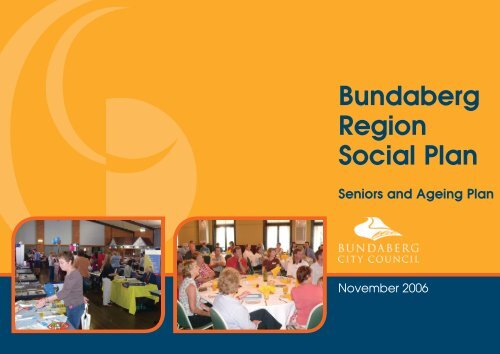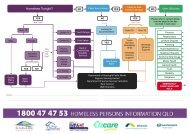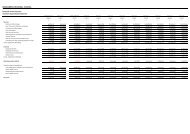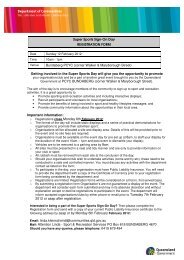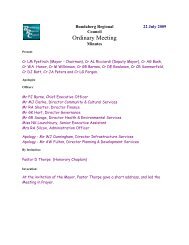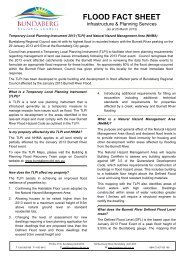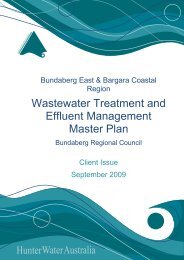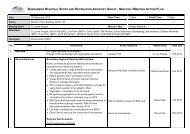Bundaberg Region Social Plan - Bundaberg Regional Council ...
Bundaberg Region Social Plan - Bundaberg Regional Council ...
Bundaberg Region Social Plan - Bundaberg Regional Council ...
You also want an ePaper? Increase the reach of your titles
YUMPU automatically turns print PDFs into web optimized ePapers that Google loves.
<strong>Bundaberg</strong><strong>Region</strong><strong>Social</strong> <strong>Plan</strong>Seniors and Ageing <strong>Plan</strong>November 2006
<strong>Bundaberg</strong> <strong>Region</strong> <strong>Social</strong> <strong>Plan</strong>Seniors and Ageing <strong>Plan</strong>Dr Jim CavayeCavaye Community DevelopmentAssisted by Mal McCulloughMcCullough GroupNovember 2006Seniors Week Expo
ContentsContentsExecutive Summary 3Introduction 5Development of the Seniors and Ageing <strong>Plan</strong> 5Ageing in Australia 6Current Activities 8Issues and Opportunities 8Recommendations 9Implementation of the Seniors and Ageing <strong>Plan</strong> 22References 24<strong>Bundaberg</strong> <strong>Region</strong> <strong>Social</strong> <strong>Plan</strong> - Seniors and Ageing <strong>Plan</strong> 1
AbbreviationsAbbreviationsACATBuCCBCDBSCATBSCCHCOTASCDWDCDESDETDHDHADLGPDSDTIEQHACCQPSQTREIQRPACAged Care Assessment Team<strong>Bundaberg</strong> City <strong>Council</strong><strong>Bundaberg</strong> Community DevelopmentBuilding Stronger Communities Action TeamBurnett Shire <strong>Council</strong>Community Health<strong>Council</strong> on the AgeingSeniors Community Development WorkerDepartment of CommunitiesDepartment of Emergency ServicesDepartment of Employment and TrainingDepartment of HousingDepartment of Health and AgeingDepartment of Local Government, <strong>Plan</strong>ning, Sport and RecreationDepartment of State Development Trade and InnovationEducation QueenslandHome and Community CareQueensland Police ServiceQueensland TransportReal Estate Institute of Queensland<strong>Region</strong>al <strong>Plan</strong>ning Advisory Committee2 <strong>Bundaberg</strong> <strong>Region</strong> <strong>Social</strong> <strong>Plan</strong> - Seniors and Ageing <strong>Plan</strong>
Executive SummaryExecutive SummaryThe <strong>Bundaberg</strong> <strong>Region</strong>, and the Burnett Shire in particular, has a higher proportion of people over the age of 55 years thanmost Australian regions. Indeed, the proportion of aged people in the Wide Bay Burnett <strong>Region</strong> is expected to double within25 years.This continued high proportion of aged persons raises many issues not only with regard to the services required and theneeds and assets of seniors, but also for the economic and social future of the region.As part of the <strong>Bundaberg</strong> <strong>Region</strong> <strong>Social</strong> <strong>Plan</strong>, the Seniors and Ageing <strong>Plan</strong> provides a set of goals and strategies for actionto address the needs of seniors and the community issues involved in an ageing population.The plan was developed by accessing a range of existing information and through discussions with representatives of seniorsgroups such as U3A and Senior Citizens, and with aged care providers in the region.Ageing in the <strong>Bundaberg</strong> <strong>Region</strong>The <strong>Bundaberg</strong> <strong>Region</strong> has a higher proportion of the population aged from 55-59 years and over compared to Queensland.The region has a pronounced “youth gap” – a decreased proportion of people aged between 19 and 39 years. There aremajor differences in the age of the population between <strong>Bundaberg</strong> City and Burnett Shire. Burnett Shire has a much greater“youth gap” and a substantially higher proportion of middle aged and retirement aged people.The composition of the population has become substantially more aged. Between 1991 and 2001 the proportion of thepopulation in all categories from 0 to 39 years has reduced considerably. The proportion of the population in each agegroup from 40 to 90 and over has markedly increased. The population increase in Burnett Shire is more concentrated in theages of 50-70 years than in <strong>Bundaberg</strong> City.Net migration into the Wide Bay Burnett <strong>Region</strong>, shows that both families and older persons are migrating to the region.However, there is substantial in-migration of people of both middle and older age groups. Indeed, the projected net inmigrationof 1,800 people over 55 years from 2004 to 2008 is the highest of any region in Queensland.<strong>Bundaberg</strong> <strong>Region</strong> <strong>Social</strong> <strong>Plan</strong> - Seniors and Ageing <strong>Plan</strong> 3
Executive SummaryIssues and OpportunitiesIssues and opportunities were raised by community members on the following topics:Service Delivery – access to services and collaboration between service providers. Improving awareness of the availabilityof services, particularly for new residents moving to the region. Improving transitions to care, the skills of aged care staff andimproving access to aged care services,Balanced community – ensuring interaction between older persons and all other sectors of the community. Overcomingsocial isolation and encouraging older persons to participate in the community,Economic Development – attracting and retaining skilled workers in health and aged care and developing economicopportunities related to the ageing population,Housing and Accommodation – improving the availability of housing, aged care and respite places, including dementia,Health and safety – improving public infrastructure such as footpaths and crossings, and encouraging greater home andpersonal safety,Transport – enhancing transport options for seniors,Promotion and Awareness – improving the “welcome” that migrants receive and helping them become more aware ofservices and opportunities to be involved in the community.4 <strong>Bundaberg</strong> <strong>Region</strong> <strong>Social</strong> <strong>Plan</strong> - Seniors and Ageing <strong>Plan</strong>
Introduction; Development of the Seniors and Ageing <strong>Plan</strong>IntroductionThe <strong>Bundaberg</strong> <strong>Region</strong>, and the Burnett Shire in particular, is expected to remain a key area attractive to seniors. The regionalready has a significantly higher proportion of people over the age of 55 compared to Queensland as a whole. The relativeconcentration of seniors in the <strong>Bundaberg</strong> region is expected to continue. The number of people over the age of 55 in theWide Bay Burnett region is expected to double within 25 years.This continued high proportion of aged persons raises many issues not only with regard to the services required and theneeds and assets of seniors, but also for the economic and social future of the region.This Seniors and Ageing <strong>Plan</strong> assesses ageing trends in the region, outlines key issues raised by community members andrecommends strategies and actions to address key issues.This Seniors and Ageing <strong>Plan</strong> is part of the <strong>Bundaberg</strong> <strong>Region</strong> <strong>Social</strong> <strong>Plan</strong>. The broader <strong>Social</strong> <strong>Plan</strong> document describes issuesand actions on many social topics and the ageing issues outlined in the Seniors and Ageing <strong>Plan</strong> need to be considered inthe context of the overall social issues in the region.Development of the Seniors and Ageing <strong>Plan</strong>The Seniors and Ageing <strong>Plan</strong> was developed using the methodology described in the <strong>Social</strong> <strong>Plan</strong>. The <strong>Social</strong> <strong>Plan</strong> involveda series of small group discussions with community members on specific topics, three open community forums, discussionsgroups with particular community sectors, feedback forms and submissions. Two discussion sessions were held specificallyon ageing with:• representatives of seniors groups such as U3A and Senior Citizens,• aged care providers in the region such as retirement villages and aged care homes.Demographic trends were analysed and information was also gained from relevant reports.<strong>Bundaberg</strong> <strong>Region</strong> <strong>Social</strong> <strong>Plan</strong> - Seniors and Ageing <strong>Plan</strong> 5
Ageing in AustraliaAgeing in AustraliaThe fastest growth of population in Australia, and in much of the western world, is in the over 65 years age group. By 2031the number of aged Australians will more than double, with 1 in 5 Australians being over 65 years (ABS, 2004). In the lastcentury, life expectancy has increased from 55 years to 76.5 years for men and from 59 years to 81.9 years for women. InQueensland, by 2051 the number of people over 65 years is expected to more than treble with the median age rising from35.0 years to 47.3 years. The Queensland Government has described ageing “as one of the most significant demographictrends shaping our world” (Office of Economic and Statistical Research, 2003).There are major differences between regions in how the ageing of the population is developing. Several types of regionsare becoming more aged as follows:• <strong>Region</strong>s where people are ageing in situ such as long-lived populations remaining in rural areas such as the DarlingDowns and Central Queensland and in some suburban areas such as inner Adelaide and Southern Melbourne,• <strong>Region</strong>s receiving retirement migration such as the Sunshine Coast and Hervey Bay,• <strong>Region</strong>s that experience the out-migration of young people. This is particularly severe in inland pastoral regions such aswestern Queensland.• <strong>Region</strong>s that received an influx of young people three or four decades previously that are now ageing. A typicalscenario is an outer suburb with young families ageing as the area becomes a middle suburb. This can occur in regionalareas that have experienced previous growth.The key issues involved in ageing for regional areas are expected to be:• The provision of services for older people such as housing, healthcare and aged care, including the increased cost ofpublic services,• The potential volunteer and partial retirement workforce offered by older people,• The opportunities for mentoring and skills transfer between older people and younger entrepreneurs,• The economic and investment opportunities for regions with an increasing proportion of people funding their retirementand receiving transfer payments, and the employment opportunities in services for aged people,6 <strong>Bundaberg</strong> <strong>Region</strong> <strong>Social</strong> <strong>Plan</strong> - Seniors and Ageing <strong>Plan</strong>
Ageing in Australia• The economic implications of some aged people on low incomes, and a proportion of aged people with limitedsuperannuation funds,• Managing the reduction in gross regional product associated with ageing. GRP per head of population is a key driverof regional economic performance and it is strongly associated with population growth. However, if populationgrowth is concentrated in age groups over 55, regional productivity will decline. Australian Local GovernmentAssociation and National Economics (2004) shows that a 1 per cent rise in population over 55 leads to a 0.4 per centreduction in regional productivity.• A trend towards partial retirements and superannuation arrangements that allow “transition to retirement” providesan economic opportunity for regions.<strong>Region</strong>s where older people can experience leisure such as hobby farms or “seachange”, or regions with scenic or culturalassets are likely to have strong aged population growth if they are within 2 hours of a significant service centre.<strong>Bundaberg</strong> <strong>Region</strong> <strong>Social</strong> <strong>Plan</strong> - Seniors and Ageing <strong>Plan</strong> 7
Current Activities; Issues and OpportunitiesCurrent ActivitiesA range of actions on ageing and seniors issues are already underway in the region as follows.Seniors NetworkA network representing seniors groups has been established in <strong>Bundaberg</strong>. The role of the Network is to:• Provide a central point for information sharing,• Develop the ability to advocate with one voice on seniors issues,• Provide opportunities to sharing resources to avoid duplication,• Facilitate the development of joint activities and actions as appropriate,• Work with all groups to ensure that seniors can readily participate in the community.The network meets quarterly and is considering working parties on particular topics. A coordinator position is proposed forthe network. It would organise action and network members would follow up with their respective groups.Multi-Purpose Learning FacilityA proposal has been forwarded to <strong>Bundaberg</strong> City <strong>Council</strong> to develop a multi purpose learning facility as part of theredevelopment of the showgrounds. This facility will be heavily utilised by U3A.Issues and OpportunitiesThe key issues raised in the community discussions are outlined below.Many residents recognised the effects of an ageing population. Some key points were:• <strong>Bundaberg</strong> is being used as a base by “grey nomads” while they travel,• The community remains conservative with an inability to change quickly,8 <strong>Bundaberg</strong> <strong>Region</strong> <strong>Social</strong> <strong>Plan</strong> - Seniors and Ageing <strong>Plan</strong>
Recommendations• Aged people are increasing demand for personal care services, and health and allied services, sourced from carefacilities and from the community generally,• There is an increasing need for social infrastructure, both hard and soft,• Although tourism in the mature age sector is increasing, the level of tourist dollars are not increasing at the same rate,due to the limited daily spending,• The lifestyle that people originally moved to the coast for is under threat from greater levels of development.People involved in discussions noted that a Seniors and Ageing <strong>Plan</strong> was required to proactively manage the expectedimpacts, opportunities and service demands from an ageing community.RecommendationsIt is recommended that a Community Implementation Board – Seniors and Aged Care be established to oversee thefollowing strategies and actions.<strong>Bundaberg</strong> <strong>Region</strong> <strong>Social</strong> <strong>Plan</strong> - Seniors and Ageing <strong>Plan</strong> 9
Goals and StrategiesGoals and StrategiesBalanced CommunityThere was strong community support for the concept of a “balanced community” with opportunities for interaction betweenolder people, young people and the community at large. People did not want elderly people separated from the restof the community. They felt that housing, services, facilities and community activities should foster interaction betweengenerations where possible. This may include:• The building of smaller retirement villages among current neighbourhoods rather than in separate locations,• <strong>Plan</strong>ning that encourages the integration of older and young people such as seniors and youth activities being locatedor operating within the same facility,• Access to services and transport as a priority consideration in housing and project planning,• Greater numbers of ‘community spaces’ that encourage people to gather together,• Greater use of school and TAFE facilities for use as learning centres at night and on weekends,• A planning scheme that encourages developers to incorporate essential services such as bus parks, hard walkfootpaths, wireless ICT, and a proportion of ‘aged specific units’ within their developments.Residents felt that there were many socially isolated older people, both within the general community in their own homesand in retirement villages. Many language and cultural barriers contribute to the isolation of elderly people from an ethnic orindigenous background. People involved in discussions felt that there were many reasons for social isolation but overcomingisolation would be a priority. This may include:• considering the needs of seniors in community events and activities,• senior citizen organisations being supported to develop an outreach role,• the recognition of individual needs in the general development of appropriate community engagement and interactionin the community,• having key people that seniors trust, such as Meals on Wheels deliverers, being in a position to refer people to socialand support opportunities.10 <strong>Bundaberg</strong> <strong>Region</strong> <strong>Social</strong> <strong>Plan</strong> - Seniors and Ageing <strong>Plan</strong>
Goals and StrategiesGoal: Develop opportunities for interaction and the participation of older persons in the communityOUTCOMEGOALSSTRATEGIESPRIORITYTIMEFRAMEPRIMERESPONSIBILITY PARTNERS LINKEDAREASOvercomingsocial isolationand enhancingthe engagementof seniors in thecommunityDevelopmentof opportunitiesfor interactionbetween olderpeople and thecommunitySupport linksbetween olderpersons groups,Foster theparticipation ofolder persons inthe community• Support the seniors network andexisting older persons groupsparticularly in developing anoutreach role to assist seniors andthe broader community to betterinteract with each other• Investigate specific opportunitiesto develop greater communitycontact with residents ofretirement homes and aged carefacilities• Investigate and lobby for adedicated Seniors CommunityDevelopment Worker• Consider changes to theplanning scheme to encouragethe integration of agedaccommodation with generalcommunity housing• Incorporate the needs of seniors incommunity events and activities• Develop the role of people thatseniors trust, such as Meals onWheels deliverers, in referringpeople to social opportunities.• Encourage communityorganisations, schools etc. to buildlinks with seniors and developspecific opportunities such asmentoring arrangements1113221ShortMedShortLongShortMedMedBCDImplementationCommitteeBCDBuCCBuCC-EventsImplementationCommitteeImplementationCommitteeAged Care/retirementAgenciesBuCCBSCSeniorsNetworkBCDBCDBSCCommunityorganisationsEQBCDAll areasHousing<strong>Bundaberg</strong> <strong>Region</strong> <strong>Social</strong> <strong>Plan</strong> - Seniors and Ageing <strong>Plan</strong> 11
Goals and StrategiesHousing and AccommodationPeople felt that current housing developments do not lend themselves to the development of a “balanced community” withopportunities for interaction being seniors and the general community. There is a need for greater integration of retirementhousing with the general community and greater opportunities for community involvement with seniors.The concept of ‘universal housing’ needs to be considered. This involves housing that can be easily modified to meet theneeds of an older person as they age so they can continue to live in the general community.In a retirement village or aged care facility, seniors may pay up to 85% of their income in accommodation and care costs.This leaves little discretionary funds and may be a factor in increased social isolation. More affordable housing for seniorsmay need investigation.Community members involved in discussions clearly preferred greater diversity of retirement and aged care housing andgreater mixing of different housing stock, rather than large retirement villages on the edges of the city. A suggestion wasfor the planning scheme to encourage developers to incorporate essential services and a number of aged specific unitswithin their developments.Managing housing demand as the “wave” of baby boomers pass through their older years is a particular issue. However,consideration also needs to be given to the future of large numbers of retirement and aged care units after the wave. Somepeople feared the creation of enclaves.12 <strong>Bundaberg</strong> <strong>Region</strong> <strong>Social</strong> <strong>Plan</strong> - Seniors and Ageing <strong>Plan</strong>
Goals and StrategiesGoal: Ensure the development of appropriate age care accommodationOUTCOMEGOALSSTRATEGIESPRIORITYTIMEFRAMEPRIMERESPONSIBILITY PARTNERS LINKEDAREASMaintainingaccess toappropriateaged careaccommodationand housingReducingunmet needand waiting listsfor aged careaccommodationand services• Lobby state and federalgovernment to gain more agedcare & HACC places1MedDHDHAAged careprovidersHACCdisabilityforumRPACBetter managingtransitions tocare• Develop stronger links withprivate developers interested inconstruction of appropriate agedcare accommodation1MedBuCCAged carefacilitiesHousing• Gain input from seniors groups andaged care providers to investigatethe issues of affordability andaccess to retirement housingservices1ShortSCDWAged careagenciesACAT• Develop appropriate transitionstrategies and programs includingspecialist transition staff2MedDHDHA<strong>Bundaberg</strong> <strong>Region</strong> <strong>Social</strong> <strong>Plan</strong> - Seniors and Ageing <strong>Plan</strong> 13
Goals and StrategiesService DeliveryMany people recognised the need for an improvement in the way that aged care services collaborate and share informationand resources. A more seamless pathway of service provision through collaborative case planning would reduce oftenstressful and repetitive situations for individuals and families. Greater partnership in service delivery would also reducecompetition between agencies for the same funding and create greater synergies in service delivery.Some specific suggestions were:• Establishment of a centralised contact point for seniors and families to access information,• Greater in-service training of the management and staff in relation to responsibilities, accountabilities and transparenciesof aged care services,• Greater consistencies in funding from state and federal agencies,• Adequate resourcing to fund ‘Ageing in Place’, for example HACC services.There needs to be greater community awareness of the difference between people being aged and people requiring frailaged care. The needs of both groups were markedly different.Waiting lists for both community and residential aged care support services are now exceeding twelve months. The largenumber of older people on waiting lists for residential care are currently being cared for by family and community servicesuntil a residential place becomes available. This places great strain on families and community services. A whole-ofgovernmentresponse is needed to reduce waiting lists for access to appropriate accommodation and other services.Services need to be developed for ‘transitions’ from family/community support to a semi supported or frail age facility.There is a need for specialist transition support staff to support families and individuals through the process of having an agedperson move from their home to a care facility.There is also a need for review of the training, qualifications, recruitment and remuneration of care staff to more fully reflectthe need for people with life skills and aptitude in these roles.14 <strong>Bundaberg</strong> <strong>Region</strong> <strong>Social</strong> <strong>Plan</strong> - Seniors and Ageing <strong>Plan</strong>
Goals and StrategiesGoal: Improve the quality and accessibility of aged care servicesOUTCOMEGOALSSTRATEGIESPRIORITYTIMEFRAMEPRIMERESPONSIBILITY PARTNERS LINKEDAREASEnhancing agedcare servicesImproving theavailability ofaged careservices• Identify and link with initiatives toattract and retain aged care andhealth professionals1MedDSDTIBuCCBSCAged careservicesSkillsformationstrategyImprovingaccess toquality agedcare services• Develop a culture amongstservices providers of consultativeservice decision making• Develop greater coordination andresource sharing between agedcare services• Develop a system of integratedcase management and referralbetween services• Greater training of the staff ofaged care services3122LongMedMedMedSCDWSCDWSCDWAged careagenciesAged careagenciesAged careagenciesDHDHADETCommunityIndustrytrainingservicesEmployment• Lobby for consistencies inequitable funding from state andfederal agencies1LongBuCCBSCSCDWDHDHA<strong>Bundaberg</strong> <strong>Region</strong> <strong>Social</strong> <strong>Plan</strong> - Seniors and Ageing <strong>Plan</strong> 15
Goals and StrategiesHealth and SafetyA long term, high profile community awareness campaign would encourage older people to develop and maintain ahealthier lifestyle and plan ahead to support their own old age requirements. Programs also can encourage communitymembers to develop and maintain their self support and independence.Encouraging seniors to engage with the community and to participate in personal development activities would helpovercome social isolation and improve personal motivation.Community programs that promote safety and security would also contribute to the safety of seniors. Improving the standardof footpaths and more aged person crossings would improve safety for aged people.Some older people, particularly indigenous people, are sometimes intimidated by the health system and hospitals reducingtheir access to appropriate care and placing a burden on their families.The equity of benefits between self funded retirees and pensioners was raised as an issue and may require further governmentreview.16 <strong>Bundaberg</strong> <strong>Region</strong> <strong>Social</strong> <strong>Plan</strong> - Seniors and Ageing <strong>Plan</strong>
Goals and StrategiesGoal: Ensure adequate health and physical safety for older personsOUTCOMEGOALSSTRATEGIESPRIORITYTIMEFRAMEPRIMERESPONSIBILITY PARTNERS LINKEDAREASMaintaining thehealth and safetyof older personsHavingadequatephysical safetyof publicspaces forolder personsImprovinghome andpersonal safetyfor agedpersons• Investigate building planningschemes that encouragedevelopers to include agedspecific infrastructure• Investigate the opportunities toappropriately improve footpathsand pedestrian access fromaged care facilities to communityfacilities• Conduct and maintain an audit ofthe safety of public footpaths andcommunity access facilities112MedShortMedBuCCBSCBuCCBSCBuccBSCDLGPDLGPBSC & BuCC,AccessCommitteeHousingDevelopappropriateinfrastructurefor olderpersons• Improve the outreach of healthservices in the community with thedelivery of basic services in less“clinical” environments• Maintain public education abouthome safety and security• Develop a home care safetyinformation pack for the ageingpopulation• Investigate the opportunities for amulti-purpose facility for seniors2321LongShortMedMedDHBSCATSCDWBuCCCHDHAAged careagenciesDCAged careagenciesSCDWSeniorsNetwork• Promote and develop activeageing programs, ie 10,000 steps1MedPopulation HealthSeniorsNetworkB’berg &Burnett Healthlifestylecommittee<strong>Bundaberg</strong> <strong>Region</strong> <strong>Social</strong> <strong>Plan</strong> - Seniors and Ageing <strong>Plan</strong> 17
Goals and StrategiesEconomic DevelopmentPeople recognised key economic issues related to ageing:• Orienting businesses and the community to the needs and opportunities involved in a more mature aged workforce,• Employment and economic opportunities in the aged care and allied services sector,• The opportunities for aged people and retirees to offer skills and time to the community as volunteers.The increasing demand for aged care services makes the attraction and retention of aged care and health professionalsparticularly important. This may involve better development and promotion of the lifestyle assets of the region, havingappropriate housing available, business development in sectors, such as ICT, and developing more higher order retailing.Goal: Development of policies that support the economic needs of seniorsOUTCOMEGOALSSTRATEGIESPRIORITYTIMEFRAMEPRIMERESPONSIBILITY PARTNERS LINKEDAREASEnsuringappropriatepolicy settingsare in placeto address theageing of thepopulation in theregionInvestigateand developlocal policieswith regard toseniors• Review the planning scheme andopportunities to encourage moreintegrated housing• Continue to lobby for support forself funded retirees22MedMedBuCCBSCSeniors NetworkDLGPBuCCBSCEnid CullenCOTAChamber ofCommerceLobby stateand federalgovernmentsfor appropriatechanges topolicy• Lobby the Federal Governmentto investigate the opportunity foran incentive scheme to employmature aged workers• Investigate the opportunityof establishing a levy for newdevelopments where a proportionis directed to aged careinfrastructure23LongLongSeniors NetworkBuCCBSCCOTA,Chamber ofCommerceCOTA,VolunteeringQld18 <strong>Bundaberg</strong> <strong>Region</strong> <strong>Social</strong> <strong>Plan</strong> - Seniors and Ageing <strong>Plan</strong>
Goals and StrategiesOUTCOMEGOALSSTRATEGIESPRIORITYTIMEFRAMEPRIMERESPONSIBILITY PARTNERS LINKEDAREASEnsuringappropriatepolicy settingsare in placeto address theageing of thepopulation in theregionEnsure skillsrequirementsare met relatingto the healthsector• Ensure issues are communicatedto local representatives on Stateand Federal Government decisionmaking bodies• Develop a formal process torecognise volunteers and the rolethey play within the community• Development of a promotionalcampaign to increase theemployment of a matureworkforce• Undertake a skills audit of theaged care, health and alliedservices sector1233ShortShortLongMedEnid CullenSeniors NetworkSeniors NetworkBuCC, BSCDLGPDSD,Chamber ofCommerce,SeniorsNetwork• Develop a strategy to ensure skillrequirements of the aged care,health and allied services sectorare met3LongBuCCBSCDSD,Chamber ofCommerce,SeniorsNetwork<strong>Bundaberg</strong> <strong>Region</strong> <strong>Social</strong> <strong>Plan</strong> - Seniors and Ageing <strong>Plan</strong> 19
Goals and StrategiesTransportThe creation of shopping centre shuttle buses that transport small numbers of people directly to neighbourhoods instead oflong trips around the city was a common issue. This needs to be considered in the development of appropriate current andfuture public transport services in the city.Goal: To provide for the transport needs of seniorsOUTCOMEGOALSSTRATEGIESPRIORITYTIMEFRAMEPRIMERESPONSIBILITY PARTNERS LINKEDAREASImprovedtransport andcommunityaccess for olderpersonsEnsuringadequatetransportoptions forolder persons• Investigate the transport optionsfor people in retirement villages onthe edge of the city• Liaise with shopping centres abouttransport options for aged persons11ShortMedBuCCBSCSCDWRPACCSDWQTSeniorsNetwork• Incorporate the needs of olderpersons in the development oftransport options2MedSCDWQTSeniorsNetwork• Work with State Government tofurther develop policies relating todisabled parking1MedBuCCBSCBuCC &BSC AccesscommitteeQT<strong>Region</strong>alAccessCommittee20 <strong>Bundaberg</strong> <strong>Region</strong> <strong>Social</strong> <strong>Plan</strong> - Seniors and Ageing <strong>Plan</strong>
Goals and StrategiesPromotion and AwarenessMany people felt that retirees that move to the <strong>Bundaberg</strong> region, particularly from urban centres, expect metropolitanlevels of service. These expectations place pressure on existing services. Greater communication about available serviceswould help people better adjust their expectations.Goal: To promote currents services and community activities to seniorsOUTCOMEGOALSSTRATEGIESPRIORITYTIMEFRAMEPRIMERESPONSIBILITY PARTNERS LINKEDAREASImprovedintegration ofseniors andseniors migratingto the regionGreaterawareness ofservices byolder personsmoving to theregionImproving the“welcome”andopportunitiesfor newresidents to beinvolved in thecommunity• Develop a “Welcome Pack” fornew residents relevant to seniors• Ensure that information aboutavailable services is up to dateon the <strong>Council</strong> and associatedwebsites and is available throughReal Estate Agents and other keycontact services11ShortShortCSDWBCDBuCCBSCBCDChamber ofCommerceDivision ofGPsCommunitySeniorsNetworkREIQBuCCBSC• Improve the availability ofinformation about communityorganisations and events inlocations that older personsattend (such as golf clubs, bowlsclubs etc)2MedCSDWBuCC-EventsAged Careagencies<strong>Bundaberg</strong> <strong>Region</strong> <strong>Social</strong> <strong>Plan</strong> - Seniors and Ageing <strong>Plan</strong> 21
Implementation of the Seniors and Ageing <strong>Plan</strong>Implementation of the Seniors and Ageing <strong>Plan</strong>It is recommended that the Seniors and Ageing <strong>Plan</strong> be implemented as part of the <strong>Bundaberg</strong> <strong>Region</strong> <strong>Social</strong> <strong>Plan</strong>. Thisinvolves the establishment of Community Implementation Board (CIB) for Seniors and Ageing that would responsible foroverseeing the implementation of strategies in the Seniors and Ageing <strong>Plan</strong>.The CIB would be constituted in the way described in the overall <strong>Social</strong> <strong>Plan</strong> as follows:• Chairperson – Shall be a community member and not a councillor, council officer or from a funding body and electedfrom the 10 member Board.• Deputy Chairperson – Shall be a community member and not a councillor, council officer or from a funding body andelected from the 10 member Board.• <strong>Council</strong>lor from <strong>Bundaberg</strong> City – appointed by <strong>Council</strong>.• Officer from <strong>Bundaberg</strong> City – appointed by <strong>Council</strong> CEO.• Representative from sector funding body – nominated by funding body.• 5(five) nominees from stakeholders within the current network or committee.The CIB would have the following roles in implementing the strategies in the Seniors and Ageing <strong>Plan</strong>:• Improve co-ordination of relevant sector stakeholder services.• Promote of high levels of community engagement.• Enhance communication between sector stakeholders and the community.• Promote the ongoing interests of the relevant sector.• Develop a whole of government approach to the stakeholder issues.• Encourage high levels of co-operation and collaboration between stakeholders.• Make recommendations to <strong>Council</strong> on stakeholder projects or issues.22 <strong>Bundaberg</strong> <strong>Region</strong> <strong>Social</strong> <strong>Plan</strong> - Seniors and Ageing <strong>Plan</strong>
Implementation of the Seniors and Ageing <strong>Plan</strong>• Undertake research and report to <strong>Council</strong> on options available, support, engagement, funding, referral.• Produce a quarterly report to <strong>Council</strong> on the Boards operations.• Develop an annual report for inclusion on the <strong>Council</strong>’s annual, State of the Community report.<strong>Bundaberg</strong> <strong>Region</strong> <strong>Social</strong> <strong>Plan</strong> - Seniors and Ageing <strong>Plan</strong> 23
ReferencesReferencesAustralian Bureau of Statistics 2004 Census of Population 2001 accessed via www.abs.gov.auAustralian Local Government Association and National Economics 2004 State of the <strong>Region</strong>s Report 2003/04 Ageing,Migration and Population Change. Australian Local Government Association, Melbourne.Australian Local Government Association and National Economics 2006 State of the <strong>Region</strong>s Report 2005/06 The Role ofInformation Technology in the Development of Economic Growth. Australian Local Government Association, Melbourne.National Institute of Economic and Industry Research (2006) The North Coast Sub-<strong>Region</strong> of the Wide Bay-Burnett <strong>Region</strong>:Demographic and Economic Change a Perspective and Prospective Analysis. A report commissioned by the Wide BayBurnett <strong>Region</strong>al Organisation of <strong>Council</strong>s.Office of Economic and Statistical Research, 2003 Population Projections to 2051. Queensland and Statistical Divisions.Queensland Government, Brisbane.24 <strong>Bundaberg</strong> <strong>Region</strong> <strong>Social</strong> <strong>Plan</strong> - Seniors and Ageing <strong>Plan</strong>
NotesNotes<strong>Bundaberg</strong> <strong>Region</strong> <strong>Social</strong> <strong>Plan</strong> - Seniors and Ageing <strong>Plan</strong>
FRONT COVER Seniors Week Expo • <strong>Bundaberg</strong> <strong>Region</strong> Learning Community BreakfastDisability Action Week Expo • Working on Wellbeing (WOW) Forum • Healthy Lifestyle Expo


